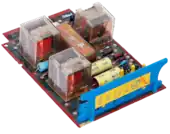Line card
A line card or digital line card is a modular electronic circuit designed to fit on a separate printed circuit board (PCB) and interface with a telecommunications access network.[1]


A line card typically interfaces with a twisted pair cable of a plain old telephone service (POTS) local loop to the public switched telephone network (PSTN). Telephone line cards perform multiple tasks, such as analog-to-digital and digital-to-analog conversion of voice, off-hook detection, ring supervision, line integrity tests, and other BORSCHT functions. In some telephone exchange designs, the line cards generate ringing current and decode DTMF signals. The line card in a subscriber loop carrier is called a subscriber line interface card (SLIC).[2][3]
A line card can terminate a line supporting voice POTS service, ISDN service, DSL service, or proprietary ones. Some line cards are capable of terminating more than one type of service.[3]
Since an access network element is usually intended to interface many users (typically a few thousand), some exchanges have multiple line terminations per card. Likewise, one network element can have many line cards.
See also
References
- "line card Definition from PC Magazine Encyclopedia". Pcmag.com. Retrieved 2014-02-19.
- "Line Card". Cscprinters.com. Retrieved 2014-02-19.
- "What is line card? - Definition from WhatIs.com". Searchitchannel.techtarget.com. Retrieved 2014-02-19.